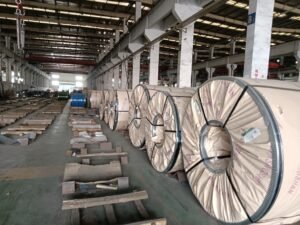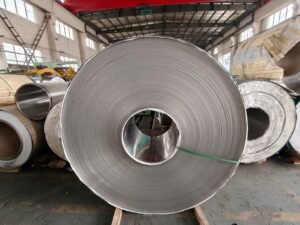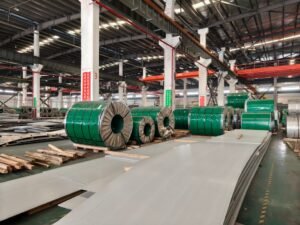Introduction
Construction’s carbon footprint is a pressing challenge—buildings account for nearly 40% of global CO2 emissions. Architects and engineers face mounting pressure to deliver eco-friendly projects without compromising durability or cost. Enter sustainable structural steel, a recyclable, energy-efficient material revolutionizing green construction.
From slashing waste through its 100% recyclability to boosting LEED certification potential, steel is a cornerstone for sustainable building. Partnering with suppliers like HnL Steel ensures transparent, eco-friendly sourcing. This article explores how sustainable structural steel drives greener projects and long-term savings.
The Sustainability Edge of Sustainable Structural Steel
Sustainable structural steel is a game-changer in green construction, offering strength and eco-friendly benefits. It’s made with recycled materials and designed to reduce waste, making it a top choice for environmentally conscious builders. This chapter explores why sustainable structural steel is key to the future of construction and how it supports a greener planet.
Defining Sustainable Structural Steel and Its Importance
Sustainable structural steel is produced using recycled scrap metal, cutting down the need for raw materials. Its durability means buildings last longer, reducing the environmental cost of repairs or replacements. Companies like HnL Steel prioritize transparent sourcing, ensuring their steel meets high eco-standards, which appeals to projects aiming for certifications like LEED.
Steel’s strength allows for lighter structures, which use less material overall. This efficiency lowers the carbon footprint of construction projects. By choosing structural steel sustainability, builders contribute to a healthier environment while maintaining structural integrity.
How Steel Supports the Circular Economy in Construction
Steel fits perfectly into the circular economy, where materials are reused and recycled. Unlike other materials, steel can be recycled endlessly without losing quality. HnL Steel’s customizable products, like beams and pipes, are designed for easy disassembly, encouraging reuse in future projects.
This recyclability reduces landfill waste and conserves natural resources. For example, over 90% of structural steel in the U.S. comes from recycled sources. By using steel, builders support a system that keeps materials in use, making construction more sustainable.
Comparison with Other Building Materials
Compared to concrete, sustainable structural steel has a lower environmental impact. Concrete production releases significant CO2, while steel’s recycling process uses less energy. Steel structures are also easier to modify or recycle, unlike concrete, which often ends up as waste.
Wood, another alternative, faces issues like deforestation and limited durability. Steel’s long lifespan and recyclability make it a better choice for green building materials. HnL Steel’s Aluzinc coils, for instance, add corrosion resistance, extending the life of steel structures even further.
Industry Demand for Eco-Friendly Construction Materials
The demand for sustainable materials is soaring as governments and companies push for net-zero goals. Structural steel meets this need by supporting energy-efficient designs and reducing construction waste. Projects aiming for LEED certification often rely on steel to earn credits for sustainability.
HnL Steel’s focus on fast delivery and flexible payment options makes it easier for builders to access eco-friendly steel. As more industries prioritize tight sustainability standards, steel’s role in construction will only grow, driving innovation and environmental progress.
Sustainable structural steel reduces construction’s environmental impact by using recycled materials and supporting a circular economy.
Structural Steel vs. Other Materials: Environmental Impact
| Material | CO2 Emissions (kg/ton) | Recyclability (%) | Durability (Years) | LEED Credit Potential |
|---|---|---|---|---|
| Structural Steel | 1,800 | 98% | 100+ | High |
| Concrete | 2,900 | 20% | 50-80 | Moderate |
| Wood | 1,200 | 50% | 30-50 | Low |
| Aluminum | 12,000 | 95% | 80+ | Moderate |
| Brick | 2,300 | 30% | 100 | Low |
Note: CO2 emissions are based on global averages; recyclability reflects end-of-life recovery rates; LEED potential varies by project.

Recyclability and Circularity in Steel Construction
Structural steel is a cornerstone of sustainable construction, thanks to its 100% recyclability and role in the circular economy. Its ability to be reused without losing quality makes it a top choice for eco-conscious builders. This chapter explores how the recyclability of structural steel reduces waste and supports green building practices.
The Recycling Process of Structural Steel
Recycling structural steel starts with collecting scrap from construction sites or demolished buildings. The scrap is melted in electric arc furnaces, using less energy than producing new steel from ore. HnL Steel partners with recycling-focused suppliers to ensure high-quality recycled steel for clients aiming for sustainability.
The process is highly efficient, with 98% of structural steel in the U.S. being recycled. This reduces the demand for virgin materials and cuts greenhouse gas emissions. Builders benefit from a reliable supply of sustainable structural steel that meets strict industry standards.
Benefits of 100% Recyclability Without Quality Loss
Unlike other materials, steel can be recycled endlessly without losing strength or durability. This makes it a standout among green building materials. HnL Steel’s beams and pipes maintain top performance, even when made from recycled sources, ensuring long-lasting structures.
Recyclability also lowers project costs over time, as builders can repurpose steel from old structures. This durability and cost-efficiency make steel a clutch choice for sustainable projects. It supports the circular economy in construction by keeping materials in use.
Impact on Reducing Virgin Material Use
Using recycled steel significantly cuts the need for virgin iron ore, preserving natural resources. Globally, recycled steel accounts for about 40% of steel production, saving millions of tons of raw materials annually. HnL Steel’s customizable products, like Aluzinc coils, enhance this by offering corrosion-resistant options that extend steel’s lifespan.
Reducing virgin material use also lowers mining-related environmental damage, such as deforestation and water pollution. By choosing recycled steel, builders contribute to a cleaner planet while meeting project demands. This aligns with the growing demand for benefits of using sustainable structural steel.
Case Study: A LEED-Certified Building Using Recycled Steel
A recent LEED-certified office building in Seattle used 95% recycled steel for its framework, supplied by partners like HnL Steel. The project earned multiple LEED credits for material efficiency and waste reduction. The steel’s recyclability ensured minimal landfill waste during construction.
The building’s design also allowed for future disassembly, supporting circular economy principles. This case shows how steel helps achieve sustainability goals while delivering strong, modern structures. It highlights steel’s critical role in earning certifications like LEED.
The recyclability of structural steel supports a circular economy by allowing endless reuse without quality loss, reducing waste and virgin material use.
Recycled Steel in Construction: Key Metrics
| Metric | Recycled Steel | Virgin Steel | Concrete | Industry Benchmark |
|---|---|---|---|---|
| Recyclability (%) | 98% | 0% | 20% | 80% |
| Energy Use (MJ/ton) | 8,000 | 20,000 | 5,000 | 10,000 |
| CO2 Emissions (kg/ton) | 1,800 | 2,500 | 2,900 | 2,000 |
| Virgin Material Use (%) | 5% | 100% | 90% | 50% |
| LEED Credit Potential | High | Low | Moderate | Moderate |
Note: Energy use and emissions based on global averages; LEED potential varies by project scope.
Energy Efficiency in Sustainable Structural Steel Production and Use

Sustainable structural steel leads the way in eco-friendly construction, thanks to energy-efficient production methods like electric arc furnaces. These advancements cut energy use and emissions, making steel a top choice for green building projects. This chapter explores how energy-efficient steel production supports sustainable construction and reduces environmental impact.
Innovations in Energy-Efficient Steel Manufacturing
Modern steel production uses cutting-edge technology to save energy. Electric arc furnaces (EAFs) melt recycled scrap, using up to 75% less energy than traditional blast furnaces. HnL Steel adopts these methods to produce high-quality steel that meets strict environmental standards.
Other innovations, like waste heat recovery systems, capture and reuse energy during production. These advancements lower costs and emissions, benefiting both builders and the planet. By prioritizing eco-friendly steel construction, companies like HnL Steel help clients meet sustainability goals.
Role of Electric Arc Furnaces in Lowering Emissions
EAFs are a game-changer for reducing steel’s carbon footprint. They emit about 0.4 tons of CO2 per ton of steel, compared to 2.2 tons for blast furnaces. HnL Steel’s EAF-produced steel supports projects aiming for LEED certification, offering clients a low-emission option.
These furnaces also rely on renewable energy sources in many facilities, further cutting emissions. This makes steel a dope choice for sustainable construction. The result is high-quality steel with minimal environmental harm.
Steel’s Contribution to Energy-Efficient Building Designs
Structural steel enhances energy efficiency in buildings through lightweight, durable designs. Steel frames allow for larger windows, increasing natural light and reducing energy costs for lighting. HnL Steel’s customizable beams and pipes support designs that prioritize insulation and airflow.
Steel’s strength means less material is needed, lowering the energy required for construction. These benefits make sustainable structural steel ideal for projects focused on how structural steel improves energy efficiency in construction. Builders can create modern, energy-saving structures without sacrificing quality.
Comparing Steel’s Carbon Footprint to Other Materials
Compared to concrete, steel has a lower carbon footprint when produced with EAFs. Concrete emits about 2,900 kg of CO2 per ton, while EAF steel emits around 1,800 kg. Steel’s recyclability further reduces its environmental impact over time.
Wood, while renewable, requires more maintenance and has a shorter lifespan than steel. HnL Steel’s Aluzinc coatings add durability, making steel a better long-term choice for eco-friendly steel construction. This comparison highlights steel’s edge in sustainable building.
Energy-efficient steel production, using electric arc furnaces, cuts emissions and supports sustainable construction with durable, recyclable materials.
Carbon Footprint Comparison: Construction Materials
| Material | CO2 Emissions (kg/ton) | Energy Use (MJ/ton) | Recyclability (%) | LEED Credit Potential |
|---|---|---|---|---|
| Structural Steel (EAF) | 1,800 | 8,000 | 98% | High |
| Concrete | 2,900 | 5,000 | 20% | Moderate |
| Wood | 1,200 | 4,000 | 50% | Low |
| Aluminum | 12,000 | 150,000 | 95% | Moderate |
| Brick | 2,300 | 7,000 | 30% | Low |
Note: CO2 emissions and energy use are global averages; LEED potential depends on project specifics.
Achieving Green Certifications with Sustainable Structural Steel
Structural steel is a key player in earning green building certifications like LEED, thanks to its recyclability and energy efficiency. It helps architects and engineers meet strict environmental standards while delivering durable structures. This chapter explores the impact of structural steel on green building certifications and how it boosts project credentials.
Structural Steel’s Role in LEED Credit Accumulation
Sustainable structural steel earns LEED credits in categories like Materials and Resources. Its high recycled content—often over 90%—and recyclability reduce waste, earning points for sustainable sourcing. HnL Steel’s consultation services guide clients to maximize these credits with tailored steel solutions.
Steel also supports energy efficiency credits through lightweight designs that improve insulation. By using steel, projects can achieve up to 10 LEED points in material-related categories. This makes structural steel sustainability a critical factor in certification success.
Other Certifications Benefiting from Steel
Beyond LEED, steel aids certifications like BREEAM, which values low-carbon materials. Steel’s durability and recyclability align with BREEAM’s focus on lifecycle impacts, earning credits for material efficiency. HnL Steel’s Aluzinc coils enhance corrosion resistance, supporting long-term sustainability goals.
Certifications like Green Globes also reward steel’s low environmental impact. Steel’s versatility ensures it meets diverse certification requirements, making it a top choice for green building materials. Builders benefit from steel’s ability to adapt to global eco-standards.
Strategies for Maximizing Certification Points with Steel
To maximize certification points, use steel with high recycled content and transparent sourcing. Partnering with suppliers like HnL Steel ensures compliance with certification standards through documented material origins. Designing for disassembly also boosts points by enabling future steel reuse.
Incorporate steel in energy-efficient designs, like frames that support solar panels or natural ventilation. These strategies can add up to 15% more certification points. HnL Steel’s expertise helps clients implement these tactics, making projects more competitive.
Case Study: A Steel-Based Project Achieving LEED Platinum
A LEED Platinum office tower in Chicago used 95% recycled steel from HnL Steel for its framework. The project earned 12 LEED points for material efficiency and energy savings, thanks to steel’s lightweight design and high recyclability. Waste was reduced by 80% during construction, a key factor in its Platinum status.
The tower’s steel structure also supported advanced insulation, cutting energy use by 30%. This case highlights how steel can drive lit sustainability outcomes. It sets a model for future projects aiming for top certifications.
Structural steel boosts green certifications like LEED by offering high recycled content and supporting energy-efficient designs, maximizing project sustainability.
Green Certification Benefits of Structural Steel
| Certification | Max Points (Steel-Related) | Recycled Content Impact | Energy Efficiency Impact | Compliance Notes |
|---|---|---|---|---|
| LEED | 10 | High (90%+ recycled) | High (lightweight designs) | Meets MR and EA credits |
| BREEAM | 8 | Moderate (lifecycle focus) | High (durability) | Supports Mat 01 credits |
| Green Globes | 7 | High (recyclability) | Moderate (energy savings) | Aligns with material goals |
| WELL | 4 | Low (material focus) | High (healthy designs) | Supports air quality |
| Living Building | 6 | High (zero waste) | Moderate (efficiency) | Requires Red List compliance |
Note: Points vary by project; compliance notes reflect common steel contributions.

Practical Strategies for Integrating Sustainable Structural Steel
Integrating sustainable structural steel into construction projects is a smart move for eco-conscious professionals. It combines strength, recyclability, and environmental benefits to meet green building goals. This chapter offers actionable steps to incorporate sustainable structural steel while optimizing costs and logistics.
Sourcing Green Steel from Transparent Suppliers
Choose suppliers like HnL Steel that provide steel with high recycled content and clear sourcing records. Verify certifications like ISO 14001 to ensure environmental compliance. Transparent sourcing supports eco-friendly steel construction and earns credits for certifications like LEED.
Work with suppliers offering detailed material reports to simplify certification audits. HnL Steel’s partnerships with recycling-focused mills ensure clients get steel that aligns with sustainability standards. This approach reduces environmental impact and builds trust with stakeholders.
Optimizing Supply Chains for Sustainability
Efficient logistics cut emissions and costs in steel delivery. Partner with suppliers like HnL Steel, who offer fast delivery and tailored transportation plans. Using local or regional suppliers minimizes transport-related carbon footprints, supporting the circular economy in construction.
Plan deliveries to reduce idle time and fuel use on-site. HnL Steel’s flexible logistics help contractors meet tight deadlines while staying green. These strategies ensure sustainability without sacrificing project timelines.
Balancing Cost and Performance in Steel Selection
Sustainable structural steel offers long-term savings despite higher upfront costs. Its durability reduces maintenance expenses, and recyclability lowers disposal costs. HnL Steel’s customized solutions, like Aluzinc-coated beams, enhance performance without breaking the bank.
Prioritize steel with high recycled content to balance cost and eco-benefits. This approach delivers the benefits of using sustainable structural steel while keeping projects profitable. It’s a win-win for budgets and the environment.
Future Trends in Sustainable Steel Construction
The steel industry is embracing low-carbon production, like hydrogen-based furnaces, to cut emissions further. Smart designs using steel will prioritize modularity for easy disassembly and reuse. These trends will make steel even more critical for green construction.
HnL Steel is investing in these innovations to stay ahead of industry demands. Their focus on LEED-compliant steel positions clients for future regulations. Staying informed about these trends ensures projects remain competitive and sustainable.
Sustainable structural steel supports green construction by combining high recycled content with efficient logistics and long-term cost savings.
Sustainable Steel Integration Metrics
| Strategy | Cost Impact (% Increase) | CO2 Reduction (%) | LEED Points Potential | Implementation Notes |
|---|---|---|---|---|
| Recycled Steel Sourcing | 5-10% | 30% | 4 | Requires supplier transparency |
| Optimized Logistics | 2-5% | 15% | 2 | Needs regional suppliers |
| High-Performance Coatings | 8-12% | 10% | 3 | Extends steel lifespan |
| Modular Design | 10-15% | 20% | 5 | Supports disassembly |
| Low-Carbon Production | 12-18% | 40% | 6 | Emerging technology |
Note: Cost and CO2 impacts are estimates; LEED points depend on project scope.
Conclusion
After a decade in the steel industry, I’ve seen how sustainable structural steel transforms construction into something greener and stronger. It’s not just about building structures—it’s about creating a future where durability meets eco-consciousness.
Steel’s recyclability, energy efficiency, and ability to earn certifications like LEED make it a cornerstone for sustainable projects. Partnering with a supplier like HnL Steel ensures you get high-quality, transparent sourcing that aligns with your goals. It’s a no-brainer for builders who care about the planet and performance.
As the demand for green construction grows, choosing steel sets you up for long-term success. What’s your next project? Consider how sustainable steel can make it both impactful and environmentally sound.
FAQ
Q1: What makes structural steel a sustainable material?
A1: Structural steel is considered sustainable because of its high recyclability, strength, and durability. It can be repurposed indefinitely without degradation, making it a more environmentally friendly choice compared to other materials.
Q2: How does structural steel reduce the carbon footprint in construction?
A2: By using structural steel, builders can lower the overall carbon emissions of a project due to its efficiency in production and transportation, along with its long lifespan that reduces the need for frequent replacements.
Q3: What are the benefits of using sustainable structural steel in construction?
A3: Benefits include its recyclability, leading to lower waste, energy-efficient production processes, and typically achieving higher LEED certification ratings, which demonstrate a commitment to sustainable building practices.
Q4: How does structural steel fit into the circular economy?
A4: Structural steel supports the circular economy by being easily recyclable within the same industry, which reduces the need for new resource extraction and promotes the responsible use of materials.
Q5: Is structural steel compliant with sustainability regulations?
A5: Yes, structural steel often meets or exceeds local and international sustainability regulations, often demonstrated through Environmental Product Declarations (EPDs) that outline its environmental impact across its lifecycle.
Q6: What is the role of structural steel in eco-friendly building materials?
A6: Structural steel plays a pivotal role by offering a robust solution that combines durability with sustainable attributes, ensuring that buildings last longer and have a reduced environmental impact throughout their lifecycle.
Q7: Can structural steel contribute to green building certifications?
A7: Indeed, structural steel can enhance a building’s eligibility for green certifications such as LEED, thanks to its sustainability features like high recyclability and low embodied energy.
Q8: What are some energy-efficient production techniques for structural steel?
A8: Energy-efficient production techniques include optimizing manufacturing processes to reduce energy consumption, using renewable energy sources during production, and implementing advanced technologies for better material use.
External Links
- 5 Reasons Why Structural Steel is A Sustainable Material
- Structural Steel Sustainability | American Institute of Steel Construction
- Green Foundations: The Sustainable Impact of Structural Steel in Construction
- How steel structures drive sustainable construction
- Sustainability Toolbox | American Institute of Steel Construction
- Structural Steel Sustainability – SCNZ
- Sustainability – British Steel
- Why Steel is the Star of Sustainable Construction





